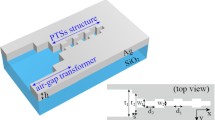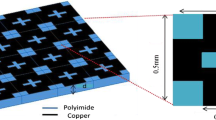Abstract
In the paper, we present a new method of restraining the Fabry–Perot resonance. The method is to combine dip angle with taper angle in the structure of the device and avoids the process of antireflection coatings. The experimental results show that restraining effect is apparent. A high threshold current has been obtained for the sample with both dip angle and taper angle structure. It provides a new method to make traveling-wave optical amplifiers.
Similar content being viewed by others
References
Saitoh, T. and J. Mukai. Lightwave Technol. LT-3 1985, 288.
Saitoh, T. and T. Mukai. Electron Lett. 23 1987, 218.
Serge, D., M. Atul, H. William et al. IEEE Photon. Technol. Lett. 6 1994, 176.
Sernyi, M. and H.U. Habermeier. Appl. Opt. 26 1987, 845.
Silver, M., A.F. Phillips, A.R. Adams et al. IEEE J. Quantum Electron. 36 2000, 118.
Yin, J., G. Du, S. Liu et al. Opt. Laser Technol. 34 2002, 595.
Author information
Authors and Affiliations
Corresponding author
Rights and permissions
About this article
Cite this article
Yin, J., Du, G., Liu, S. et al. A new method of restraining the Fabry–Perot resonance. Optical and Quantum Electronics 35, 873–878 (2003). https://doi.org/10.1023/A:1024453627234
Issue Date:
DOI: https://doi.org/10.1023/A:1024453627234




